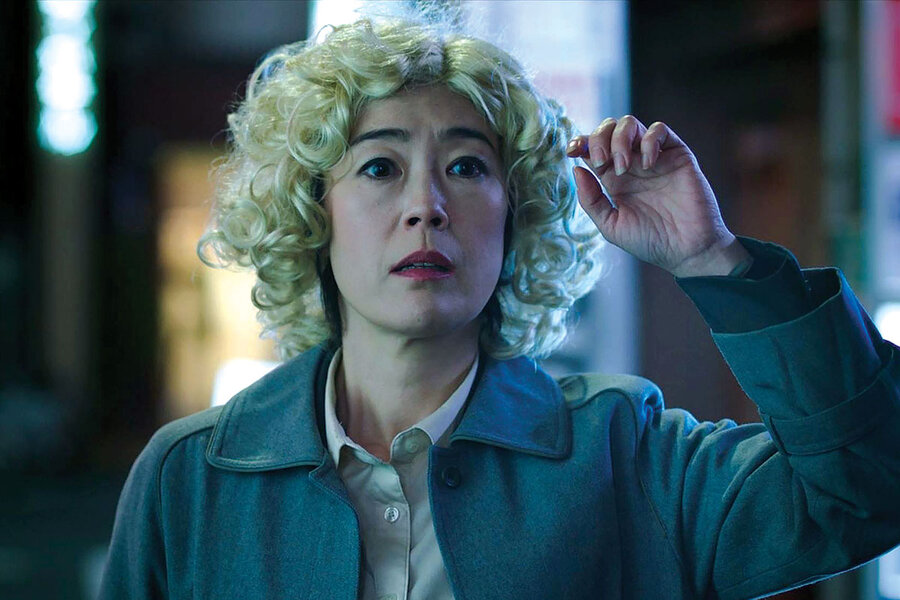‘Oh Lucy!’ portrays L.A. from a down-and-outer’s view
Loading...
“Oh Lucy!” is a small-scale curiosity that lingers in the mind. Expanded from a prize-winning 2014 short film by its writer-director, Atsuko Hirayanagi, it’s about Setsuko Kawashima (Shinobu Terajima), an unmarried middle-aged data processor who is decades older than most of her co-workers in the drab office where she joylessly toils.
Early on in the movie, a sweet-souled older woman has a retirement party where she is presented with flowers and a teddy bear. Chafing at what she perceives to be the hypocrisy behind all the good cheer, Setsuko, before stumbling out, loudly informs the honoree that her co-workers often made cruel fun of her behind her back. Later that night, sobered up, she sees the sad-faced woman clutching her flowers, waiting on the opposite side of the subway tracks, and calls out to her, “I’m sorry.” She gets no response in return.
Setsuko may not seem like the kind of person you want to spend time in a movie theater with, let alone at a party, but Hirayanagi at least allows us to see how pain and loneliness have warped her. The film’s viewpoint is unsentimental but compassionate. We discover incrementally more about Setsuko as the film meanders along and she proves somewhat more complicated than we might initially have imagined.
Setsuko’s life changes when her pretty young niece, Mika (Shioli Kutsuna), asks if she can take over her tuition for some English classes Mika can no longer attend. She reluctantly takes her niece’s place in a one-on-one session with the instructor, John (Josh Hartnett), a gregarious American who believes his Japanese students need to loosen up in order to properly learn “American English.” He encourages hugging and provides Setsuko with a blond wig and an American name – Lucy.
Setsuko/Lucy is simultaneously flummoxed and bedazzled, and sure enough, the wearing of the wig brings out a playfulness she once seemed incapable of expressing. But returning, warily, to her next session, she discovers that John has moved back to Los Angeles. What’s more, Mika left with him.
Hirayanagi captures the deadening sameness of Setsuko’s life so precisely that when she takes vacation time to follow John and Mika to America her expedition seems less crazy than liberating. She travels with her sister, Ayako (Kaho Minami), Mika’s mother, in tow. She has a fraught relationship with Ayako because she believes Ayako stole her old boyfriend (whom she subsequently married). In contrast to the grayed-out gloom of Tokyo, the Los Angeles of this movie is brighter but also seedier. Hirayanagi avoids highlighting anything iconic or touristy. The run-down motel where they find John – Mika has already left him – complements the landscape of mini-malls, fast-food joints, and tattoo parlors. This is Los Angeles from a down-and-outer’s perspective; the sunbaked drabness seems lived-in.
The film’s chief defect is that Setsuko is set up to be more complex than Hirayanagi ultimately allows her to be. Is her pursuit of John, who is somewhat of a blank and is quizzically indulgent of her quest, an act of derangement or ardor? Of course, it could be both, but we rarely see how these two psychological states coexist within her. The film itself could use a blond wig – it needs to be far more expansive, antic, and disturbing than it is. When things take a dark turn near the end, the events don’t grow organically from those that came before.
Still, Setsuko’s pathetic attempt to claim a new life for herself is touching. The film never makes fun of her. And there are sequences early on in the movie, such as her tentative confab with a fellow bewigged student, a shy widower (Kôji Yakusho), that bring out the grace notes in their shared loneliness. These are the moments in “Oh Lucy!” that stay with you. Grade: B- (This movie is not rated.)







